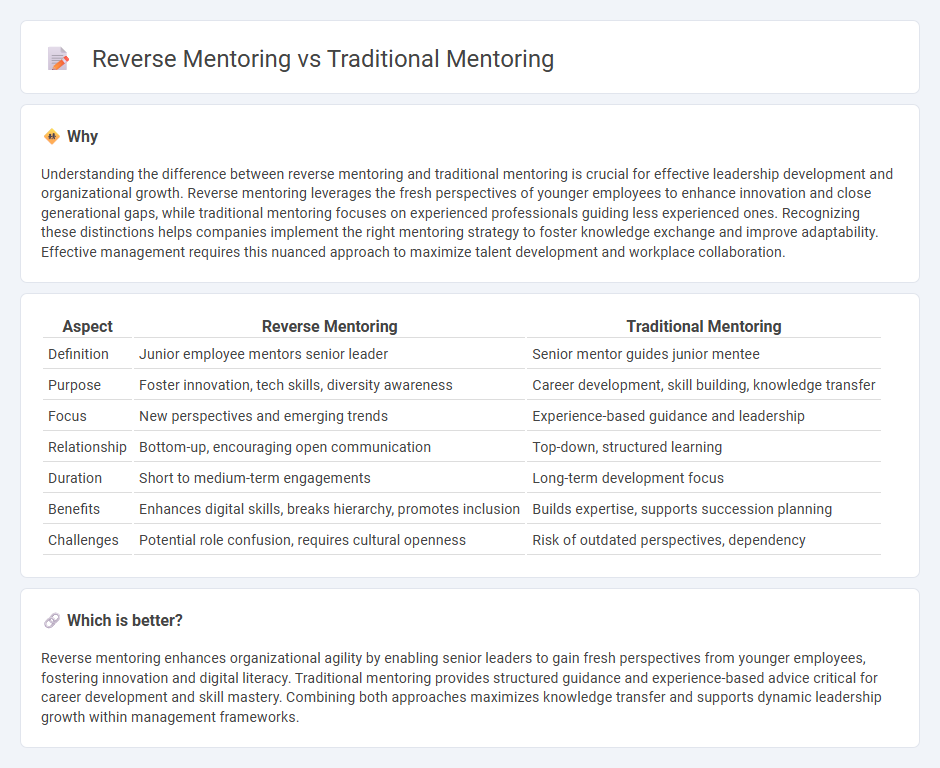
Reverse mentoring flips traditional mentoring by having younger employees share knowledge and fresh perspectives with senior leaders, fostering innovation and reducing generational gaps. Traditional mentoring typically involves experienced professionals guiding less experienced colleagues to develop skills and advance careers. Explore further to understand which mentoring style best suits your organizational goals.
Why it is important
Understanding the difference between reverse mentoring and traditional mentoring is crucial for effective leadership development and organizational growth. Reverse mentoring leverages the fresh perspectives of younger employees to enhance innovation and close generational gaps, while traditional mentoring focuses on experienced professionals guiding less experienced ones. Recognizing these distinctions helps companies implement the right mentoring strategy to foster knowledge exchange and improve adaptability. Effective management requires this nuanced approach to maximize talent development and workplace collaboration.
Comparison Table
| Aspect | Reverse Mentoring | Traditional Mentoring |
|---|---|---|
| Definition | Junior employee mentors senior leader | Senior mentor guides junior mentee |
| Purpose | Foster innovation, tech skills, diversity awareness | Career development, skill building, knowledge transfer |
| Focus | New perspectives and emerging trends | Experience-based guidance and leadership |
| Relationship | Bottom-up, encouraging open communication | Top-down, structured learning |
| Duration | Short to medium-term engagements | Long-term development focus |
| Benefits | Enhances digital skills, breaks hierarchy, promotes inclusion | Builds expertise, supports succession planning |
| Challenges | Potential role confusion, requires cultural openness | Risk of outdated perspectives, dependency |
Which is better?
Reverse mentoring enhances organizational agility by enabling senior leaders to gain fresh perspectives from younger employees, fostering innovation and digital literacy. Traditional mentoring provides structured guidance and experience-based advice critical for career development and skill mastery. Combining both approaches maximizes knowledge transfer and supports dynamic leadership growth within management frameworks.
Connection
Reverse mentoring and traditional mentoring complement each other by fostering bi-directional knowledge exchange between generations. While traditional mentoring involves experienced leaders guiding juniors in leadership and organizational skills, reverse mentoring allows younger employees to share insights on technology, trends, and innovative practices. Integrating both approaches enhances organizational learning, promotes diversity of thought, and strengthens leadership development programs.
Key Terms
Hierarchical Structure
Traditional mentoring typically involves a senior employee guiding a junior colleague, reinforcing a top-down hierarchical structure where knowledge flows from experienced leaders to less experienced employees. Reverse mentoring flips this dynamic, enabling younger or less senior employees to teach senior leaders about new technologies, trends, or social perspectives, thus flattening hierarchical barriers and fostering mutual learning. Discover how these mentoring models impact organizational culture and leadership development strategies.
Knowledge Flow Direction
Traditional mentoring involves experienced professionals transferring knowledge to less experienced mentees, fostering skill development and organizational culture adherence. Reverse mentoring reverses this flow, with younger or less experienced individuals sharing insights on technology, social trends, and contemporary skills. Explore the unique benefits and challenges of each mentoring approach to optimize your organizational learning strategy.
Generational Perspective
Traditional mentoring typically involves an experienced senior guiding a less experienced junior, emphasizing knowledge transfer from older to younger generations, fostering professional growth through established industry wisdom. Reverse mentoring flips this dynamic, with younger employees sharing technological skills, digital trends, and fresh perspectives with senior leaders, bridging generational gaps and promoting innovation. Explore how adopting both mentoring styles can optimize workforce collaboration across diverse age groups.
Source and External Links
Mentoring Styles | EDUCAUSE - Traditional mentoring is a supportive learning relationship where a mentor shares knowledge and experience with a mentee to enrich their professional journey.
Traditional Mentoring vs Modern Mentoring - Insala - Traditional mentoring allows for deep personal connections between mentor and mentee, focusing on advice, direction, and long-term development through uninterrupted attention.
What Is Mentoring? - Association for Talent Development - One-on-one mentoring, the most traditional type, pairs a more experienced mentor with a less experienced mentee for growth, learning, and career development, often within an organizational context.
 dowidth.com
dowidth.com